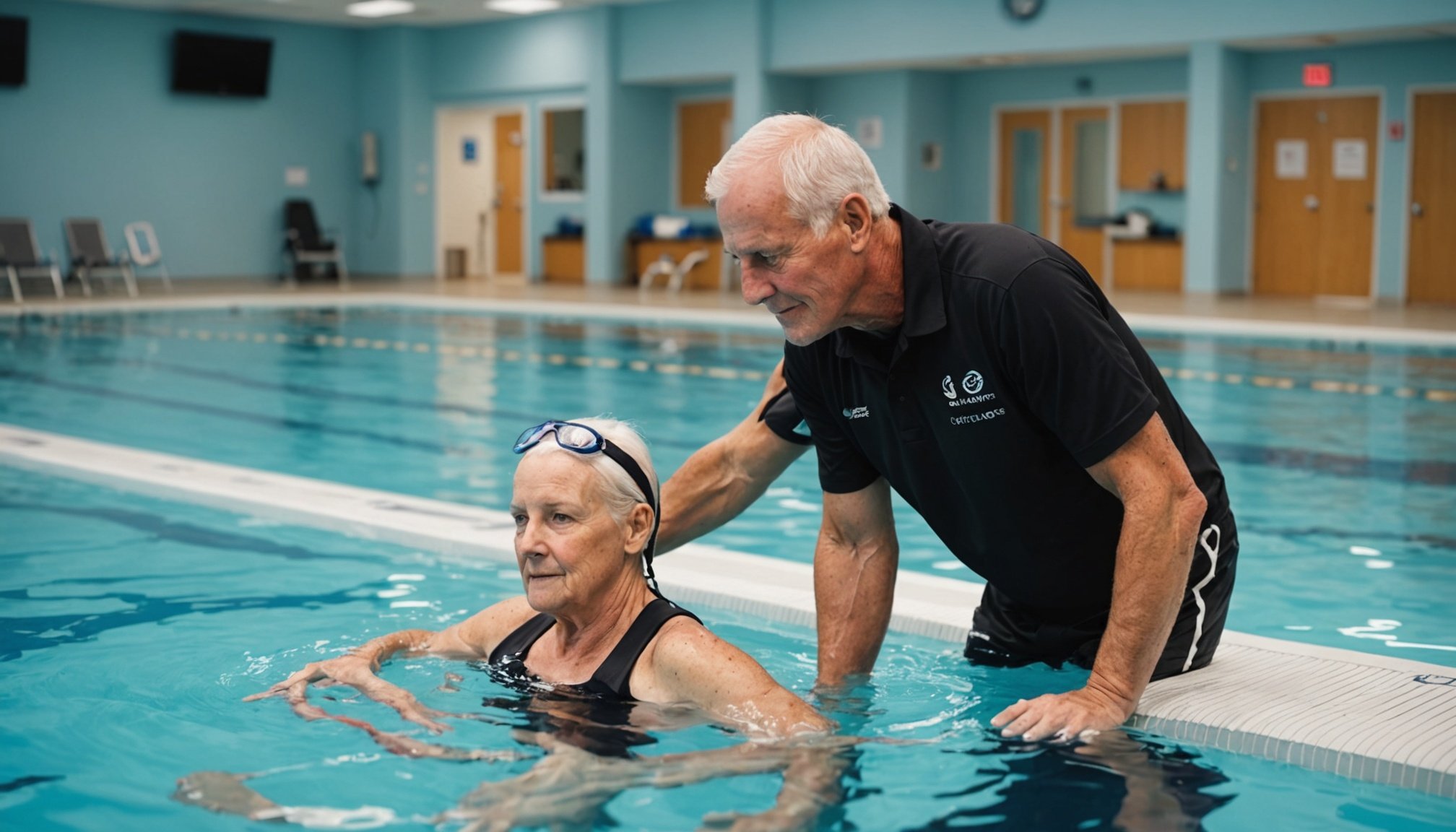Transforming Spinal Cord Injury Recovery: The Potential Benefits of Aquatic Therapy
Understanding Spinal Cord Injuries
Spinal cord injuries (SCI) are among the most debilitating and life-altering conditions an individual can face. These injuries can result from various causes, including accidents, falls, or even medical conditions like spinal cord strokes. The impact of an SCI is not just physical but also emotional and psychological, affecting every aspect of an individual’s life.
For individuals with SCI, the road to recovery is often long and challenging. Traditional rehabilitation methods, while effective, may not always address the full spectrum of needs for these patients. This is where aquatic therapy emerges as a promising and holistic approach to rehabilitation.
Also read : Exploring the Impact of Daily Curcumin Intake on Inflammatory Markers in Rheumatoid Arthritis Management”
What is Aquatic Therapy?
Aquatic therapy, also known as hydrotherapy or pool therapy, involves performing exercises and stretches in a pool under the guidance of a trained therapist. This form of therapy leverages the unique properties of water to provide a supportive and low-impact environment for rehabilitation.
Physiological Benefits of Water Immersion
When individuals are immersed in water, several physiological changes occur that are particularly beneficial for SCI rehabilitation:
Also to discover : Unlocking Healing: The Transformative Power of Art for Those with Post-Traumatic Stress Disorder
- Reduced Gravity: Water reduces the body’s weight, minimizing the impact on joints and muscles, which is crucial for individuals with spinal cord injuries who may have limited mobility or chronic pain[5].
- Increased Buoyancy: The buoyancy of water allows for greater mobility and range of motion without the risk of falls or further injury.
- Improved Circulation: Water immersion enhances blood circulation, which can aid in the healing process and reduce swelling.
- Relaxation and Reduced Muscle Spasm: The warmth of the water can relax muscles and reduce spasms, providing significant relief for individuals with SCI.
Benefits of Aquatic Therapy for SCI Rehabilitation
Aquatic therapy offers a multitude of benefits that make it an invaluable component of SCI rehabilitation.
Pain Management
One of the most significant challenges for individuals with SCI is managing chronic pain. Aquatic therapy has been shown to be highly effective in this area:
- Natural Pain Relief: The warmth and buoyancy of the water provide natural pain relief by reducing the pressure on the spinal cord and surrounding muscles[1].
- Reduced Inflammation: Water exercises can help reduce inflammation, which is a common cause of pain in SCI patients.
Improved Muscle Strength and Mobility
Aquatic therapy is designed to improve muscle strength and mobility without the high-impact stress associated with land-based exercises:
- Resistance Training: Water provides natural resistance that helps build muscle strength without the need for heavy weights.
- Range of Motion Exercises: The buoyancy of water allows for a greater range of motion, helping to maintain or improve flexibility and mobility[3].
Enhanced Mental Health
The psychological impact of an SCI cannot be underestimated. Aquatic therapy also offers several mental health benefits:
- Stress Reduction: The relaxing environment of the pool can significantly reduce stress and anxiety.
- Improved Mood: The sense of accomplishment from performing exercises in the water can boost mood and overall mental well-being.
Practical Applications and Exercises
Aquatic therapy is not just a theoretical concept; it is a practical and actionable approach to rehabilitation. Here are some common exercises and applications:
Gait Training
Gait training in the pool is particularly beneficial for SCI patients as it allows them to practice walking in a safe and supportive environment.
- Walking and Jogging: Patients can walk or jog in the pool, which helps in regaining balance and coordination.
- Assisted Walking: Therapists can provide support and assistance while the patient walks, reducing the risk of falls.
Stretching and Strengthening
- Upper Body Exercises: Patients can perform arm circles, shoulder rolls, and other upper body exercises to improve muscle strength and flexibility.
- Lower Body Exercises: Leg lifts, knee bends, and other lower body exercises can be done to strengthen the muscles and improve mobility.
Occupational Health Integration
Aquatic therapy can also be integrated with occupational health practices to help individuals regain daily living skills:
- Daily Activities Simulation: Patients can practice daily activities like bathing, dressing, or even cooking in a simulated environment within the pool.
- Fine Motor Skills Training: Exercises can be designed to improve fine motor skills, such as grasping and manipulating objects.
Comparative Benefits: Aquatic Therapy vs. Traditional Rehabilitation
Here is a comparative table highlighting the benefits of aquatic therapy over traditional rehabilitation methods for SCI patients:
| Aspect | Aquatic Therapy | Traditional Rehabilitation |
|---|---|---|
| Impact on Joints | Low-impact, reduces stress on joints and muscles | High-impact, may exacerbate joint pain and injury |
| Pain Management | Natural pain relief through water immersion and reduced inflammation | Often requires medication or invasive procedures |
| Muscle Strength | Builds muscle strength through water resistance | May require heavy weights or machinery |
| Mobility Improvement | Enhances mobility through buoyancy and reduced gravity | Limited mobility due to high-impact exercises |
| Mental Health Benefits | Reduces stress and anxiety, improves mood | May not address mental health as comprehensively |
| Safety | Safe environment with reduced risk of falls | Higher risk of falls and further injury |
| Patient Engagement | High patient engagement due to the enjoyable and relaxing environment | May be less engaging due to the rigorous nature of traditional exercises |
Real-Life Examples and Success Stories
Aquatic therapy has transformed the lives of many individuals with SCI. Here is a compelling example:
From Swimmer to Survivor
A competitive swimmer who suffered a spinal cord stroke found aquatic therapy to be a lifeline in her recovery. Despite the initial prognosis that spinal cord strokes have less potential for recovery compared to other injuries, she made significant progress through aquatic therapy. The water environment allowed her to regain some mobility and strength, and she was eventually able to return to swimming, albeit in a modified form[4].
Future Directions and Innovations
As aquatic therapy continues to evolve, several innovations are on the horizon that could further enhance its benefits.
Virtual Reality Integration
Virtual reality (VR) is being explored as a tool to enhance the engagement and effectiveness of aquatic therapy. VR can provide immersive and interactive environments that make exercises more engaging and fun.
Advanced Pool Technologies
Modern pools are being equipped with advanced technologies such as adjustable water temperatures, resistance jets, and even underwater treadmills. These technologies can tailor the aquatic therapy experience to the specific needs of each patient.
Aquatic therapy is a powerful tool in the rehabilitation of individuals with spinal cord injuries. By leveraging the unique properties of water, it offers a holistic approach to pain management, muscle strength improvement, and mental health enhancement. As this field continues to evolve with new technologies and innovations, it holds great promise for transforming the lives of those affected by SCI.
For individuals and healthcare providers looking to incorporate aquatic therapy into their rehabilitation plans, here are some practical tips:
- Consult a Specialist: Ensure that the aquatic therapy program is guided by a trained therapist who specializes in SCI rehabilitation.
- Start Slow: Begin with gentle exercises and gradually increase intensity as the patient becomes more comfortable and stronger.
- Monitor Progress: Regularly monitor the patient’s progress and adjust the therapy plan as needed.
By embracing aquatic therapy, we can significantly improve the quality of life for individuals with SCI, helping them to regain mobility, manage pain, and achieve a better overall health and well-being.











